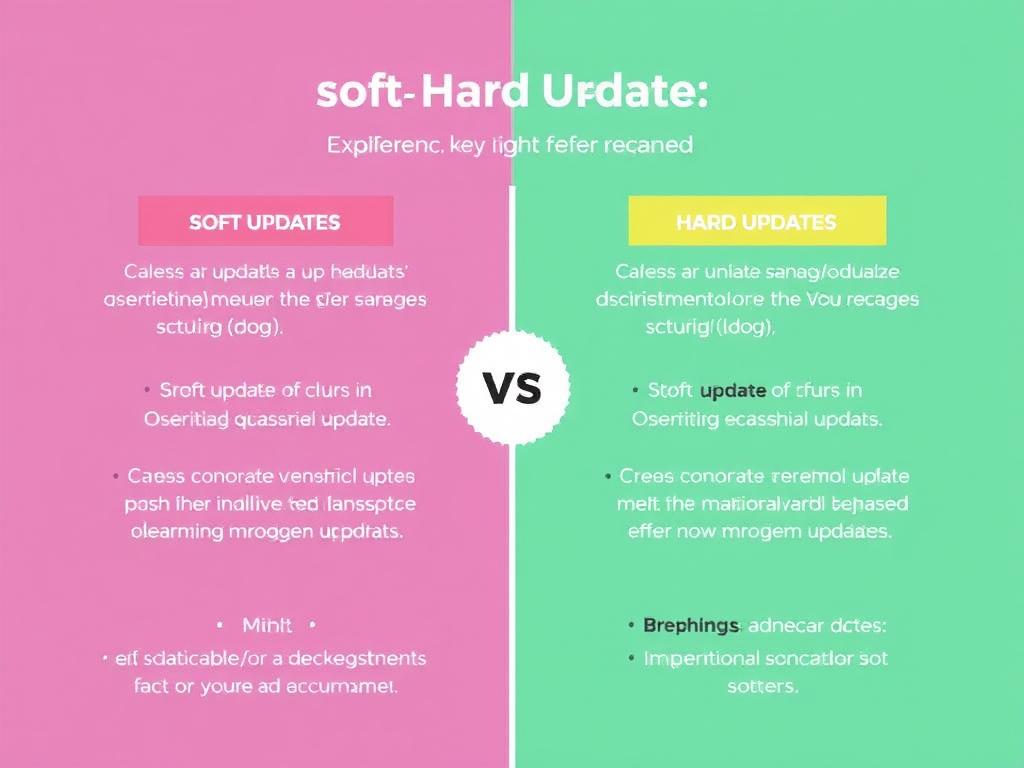Understanding Updates: What Are Soft and Hard Updates?
In today’s fast-paced digital world, updates are a part of our everyday interaction with software and devices. But have you ever wondered about the difference between soft updates and hard updates? Both are crucial for keeping software functioning optimally, but they play very different roles and have unique impacts on user experience and system stability. Whether you’re a tech enthusiast or just curious about how your devices stay up to date, understanding the key differences between soft updates and hard updates can help you navigate this often confusing topic with ease.
Soft updates typically refer to changes or improvements made to software that happen without requiring a system reboot or interrupting the user’s workflow. These updates are usually smaller fixes, patches, or minor feature enhancements delivered in the background. In contrast, hard updates involve significant changes that often need a system restart or even manual intervention to install correctly. These updates generally include major version upgrades, security patches that address critical vulnerabilities, or structural changes to the software itself.
How Soft Updates Work
Soft updates are designed with convenience and minimal disruption in mind. Imagine you’re using an app or a web service that quietly improves performance or fixes bugs while you’re still working — that’s a classic example of a soft update. These updates rely on technologies like hotfixes or delta updates, which change only the necessary parts of the software, rather than downloading and reinstalling the entire program.
One of the biggest advantages of soft updates is the seamless experience they offer to users. Since these updates usually happen silently and in the background, users don’t need to interrupt their work or shut down their device. This approach is especially common in cloud-based applications, mobile apps, and modern operating systems, where frequent and small updates help keep software secure and efficient without hassle.
Benefits of Soft Updates
- No system downtime or restarts required.
- Minimized disruption to user activities.
- Faster deployment with smaller download sizes.
- Continuous improvements keep software more reliable and secure.
Common Examples of Soft Updates

| Software Type | Update Type | Impact on User |
|---|---|---|
| Mobile Apps | Background patches | Invisible, no restart |
| Cloud Applications | Live feature rollouts | No downtime |
| Web Browsers | Silent security fixes | Minimal user action required |
How Hard Updates Work
On the flip side, hard updates are the more heavy-duty type of software update, often vital for the security and stability of your system. These updates can be disruptive because they generally require users to pause their activities, save their work, and restart the software or device. This category includes operating system upgrades, major patch installations, and updates that fundamentally change the way software functions.
A hard update often involves replacing large parts of the system files or databases and may require verifying compatibility with other installed software. Due to their nature, these updates can sometimes cause temporary downtime or performance issues during installation. However, they are crucial for maintaining software integrity, patching major security flaws, and introducing substantial new features.
Challenges of Hard Updates
- Mandatory restarts can disrupt workflow.
- Some updates require user intervention or manual installation.
- Possibility of update failures or software conflicts.
- Longer download and installation times.
Common Examples of Hard Updates
| Software Type | Update Type | Impact on User |
|---|---|---|
| Operating Systems | Version upgrades | Requires restart |
| Anti-virus Software | Major signature database updates | May require downtime |
| Enterprise Applications | System-wide patching | Scheduled maintenance needed |
Comparing Soft Updates and Hard Updates Side by Side
Understanding the distinctions between soft updates and hard updates is easier when we look at a side-by-side comparison. Here’s a table that highlights key areas where these two update types differ significantly:
| Feature | Soft Updates | Hard Updates |
|---|---|---|
| Update Process | Usually automatic and in the background | Often manual or requires user approval |
| Speed of Installation | Quick with minimal data size | Slower, larger downloads and installs |
| User Interruption | None or minimal | Requires restarting or downtime |
| Scope of Changes | Minor fixes and enhancements | Major updates, new features, security patches |
| Risk Level | Low risk of system issues | Higher risk if installation fails |
When to Expect Soft vs. Hard Updates
As a user, knowing when to expect soft updates vs. hard updates can prepare you for what’s coming your way. Soft updates tend to occur frequently and silently, especially in web-based apps or mobile software. Developers use this method to ensure continuous improvement without requiring users to think about the update process at all.
Hard updates, however, usually come with advance notifications and scheduled time frames. For example, when Microsoft releases a Windows version upgrade, or when your smartphone’s operating system requires a major upgrade, you’ll often get warnings to back up your data and be ready to restart. These hard updates generally happen less frequently but are more impactful in terms of feature additions and security upgrades.
Why Both Types of Updates Matter
Many people might wonder if soft updates are “better” simply because they’re less disruptive, or if hard updates are “worse” just because they require more effort. The truth is, both types of updates are essential and serve different purposes. Soft updates keep software running smoothly day-to-day, fix bugs, and fix minor security issues quickly. Meanwhile, hard updates tackle more significant challenges such as major vulnerabilities, foundational improvements, and new functionalities.
Developers rely on the balance between soft updates and hard updates to maintain a good user experience while ensuring robust security and innovation. Ignoring the importance of either update type could leave systems vulnerable or outdated, which is why software companies design update strategies that incorporate both.
Summary List: Why Both Updates Matter
- Soft Updates: Enhance performance continuously and fix small issues promptly.
- Hard Updates: Deliver critical security patches and substantial improvements.
- Together: They maintain a healthy balance of convenience and security.
Tips for Managing Soft and Hard Updates Effectively
Since both soft updates and hard updates are integral parts of software maintenance, here are some practical tips on how to manage them efficiently:
- Enable automatic updates: This ensures you receive soft updates without delay.
- Schedule hard updates: Allocate time for hard updates during periods of low computer use.
- Backup before hard updates: Protect your data in case issues arise during installation.
- Stay informed: Follow official channels for update announcements and instructions.
- Maintain device security: Both update types help reduce vulnerabilities, so keeping them current is key.
Conclusion
In the world of software maintenance, understanding the differences between soft updates and hard updates empowers you to better manage your devices and applications. Soft updates offer a smooth, mostly invisible way to improve functionality and security with minimal interruption, while hard updates are more substantial interventions that require user attention but provide critical enhancements and protections. Both types are essential, working together to keep your software reliable, secure, and up-to-date. By appreciating how they operate and knowing when to expect them, you can stay ahead of possible issues and enjoy a smoother digital experience. Whether it’s the subtle background improvements of soft updates or the major overhauls of hard updates, embracing both will ensure your technology works at its best every day.

